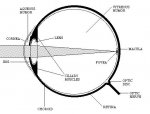Y
yew.sir-name
Guest
Laser Radiation Bioeffects
found this http://radsafe.berkeley.edu/lsts1101e.html
i like the part where it says:
"Eye Injury Potential
The potential location of injury in the eye (see Appendix E - Eye Component Diagram) is directly related to the wavelength of the laser radiation. For laser radiation entering the eye:
Wavelengths shorter than 300 nm or longer than 1400 nm are absorbed in the cornea.
Wavelengths between 300 and 400 nm are absorbed in the aqueous humor, iris, lens, and vitreous humor.
Wavelengths between 400 nm and 1400 nm are focused onto the retina."
and
"Laser retinal injury can be severe because of the focal magnification (optical gain) of the eye that is approximately 105. This means that an irradiance of 1 mW/cm2 entering the eye will be effectively increased to 100 W/cm2 when it reaches the retina."
do you think they mean mw?
found this http://radsafe.berkeley.edu/lsts1101e.html
i like the part where it says:
"Eye Injury Potential
The potential location of injury in the eye (see Appendix E - Eye Component Diagram) is directly related to the wavelength of the laser radiation. For laser radiation entering the eye:
Wavelengths shorter than 300 nm or longer than 1400 nm are absorbed in the cornea.
Wavelengths between 300 and 400 nm are absorbed in the aqueous humor, iris, lens, and vitreous humor.
Wavelengths between 400 nm and 1400 nm are focused onto the retina."
and
"Laser retinal injury can be severe because of the focal magnification (optical gain) of the eye that is approximately 105. This means that an irradiance of 1 mW/cm2 entering the eye will be effectively increased to 100 W/cm2 when it reaches the retina."
do you think they mean mw?




